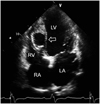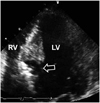Abstract
Aneurysm of the sinus of Valsalva that causes dissection of the interventricular septum is an extremely rare entity. In this report we describe a case of aneurysm of the sinus of Valsalva dissecting into the interventricular septum, from the base to mid septum, after aortic valve replacement. After the diagnosis was made by transthoracic echocardiography and magnetic resonance imaging, the patient was successfully treated with surgical sealant-mediated occlusion of the aneurysmal sac and cardiac resynchronization therapy used for the first time.
Aneurysms of the sinus of Valsalva (ASVs) dissecting into the interventricular septum have been rarely reported.1-4) and those developing after aortic valve replacement (AVR) are even rarer, with only 3 cases reported in the Korean- and English-language literature to date.5-7) In this article, we review and discuss an extremely rare case of dissecting aneurysm of the interventricular septum as a long-term complication of AVR, which was diagnosed by transthoracic echocardiography (TTE) and magnetic resonance imaging (MRI) and treated by occlusion of the aneurysmal sac using a surgical sealant and cardiac resynchronization therapy (CRT) used for the first time.
A 50-year-old woman, who presented with severe dyspnea on exertion, had undergone AVR (23 mm St. Jude Medical® mechanical heart valve) for severe aortic regurgitation and permanent epicardial pacemaker implantation (VVIR) for complete atrioventricular block, at our hospital 17 years ago. At the time of admission, a systolic murmur was heard at the apex (grade II) on auscultation, and pitting edema of both lower legs was apparent on physical examination. Electrocardiogram (ECG) showed complete left bundle branch block with a wide QRS interval of about 200 milliseconds (Fig. 1); and chest roentgenogram showed increased pulmonary vascular markings with cardiomegaly. TTE showed a well functioning prosthetic aortic valve; however, a huge dissecting cystic mass-like aneurysm in the interventricular septum (5×3.5 cm) from the base to mid-septum was revealed (Fig. 2) and diastolic flow communicating from aortic root to interventricular aneurysm was seen on color Doppler echocardiography (Fig. 3). Severe global left ventricular (LV) hypokinesis with LV dyssynchrony and LV enlargement and reduced LV systolic function with 18% ejection fraction and mild mitral regurgitation were also seen on color Doppler echocardiography. MRI demonstrated similar findings and revealed the opening of the peri-prosthetic leak into the interventricular septum with aneurysmal change (Fig. 4). Compression or displacement of the left coronary artery by the interventricular septal aneurysm was not observed during preoperative coronary angiography. The patient was taken for surgery to correct the dissecting aneurysm of the interventricular septum for preventing potential complications. Surgical field showed that the aneurysmal opening, 5 mm in diameter, was located between the left coronary ostium and the mechanical aortic valve annulus (Fig. 5). Although there was no paravalvular leakage around the mechanical aortic valve, direct closure of the aneurysmal opening with sutures was impossible because of severe calcification around the opening. Therefore, occlusion of the aneurysmal sac with surgical sealant, Beriplast® (ZLB Behring AG, Marburg, Germany) and CoSeal® (Baxter International Inc., Deerfield, IL, USA) with subsequent reinforcement with a prosthetic patch, Gore-Tex® (W.L. Gore & Associates, Inc., Flagstaff, AZ, USA) was carried out. The patient underwent removal of the epicardial pacemaker due to pacemaker dysfunction and CRT was performed due to LV dysfunction with LV dyssynchrony. The postoperative course was uneventful and the patient was discharged after 18 days in a satisfactory condition. The 6-month follow-up echocardiographic study revealed that LV systolic function had improved from 18% to 41% of LV ejection fraction, and aneurysmal size had decreased from 5.0×3.5 cm to 3.2×1.8 cm (Fig. 6), while on ECG QRS width was moderately decreased from 200 msec to 120 msec. Until now, no specific problems have been revealed on the subsequent follow-ups.
ASVs are rare and account for 0.14% to 1.5% of the cardiac surgical load.8-10) Congenital ASVs are more common than acquired ASVs.6) Acquired ASVs are caused by conditions affecting the aortic wall, such as infections (bacterial endocarditis, syphilis, or tuberculosis); chest trauma; or degenerative diseases (atherosclerosis, connective tissue diseases, or cystic medical necrosis).3)4)11-14) Complications of ASV include arrhythmia, atrioventricular block, obstruction of ventricular outflow tract, aortic insufficiency, congestive heart failure, and multidirectional rupture with embolic event, with the most common complication being atrioventricular conduction disturbance among the reported cases.5)6)13)18)19) Dissection of the interventricular septum is a very rare complication of sinus of Valsalva aneurysm, in which case the interventricular septum is dissected and forms an aneurysm which bulges into both the left and right ventricles, causing obstruction of both ventricular outflow tracts.4) It communicates with the aortic root, and may communicate with the ventricle.7) The etiology of this disease remains obscure. The ASV compresses the coronary arteries leading to ventricular septal ischemia.15) Other potential causes include intraseptal rupture of ASV and/or hematoma formation.2)13) In this case, the cause of aneurysm formation with dissection into the interventricular septum is presumed to be the postoperative shear stress due to turbulent flow against the weak tissue between the interventricular septum and the prosthetic aortic valve. In addition, direct pressure by the expanding aneurysm is considered responsible for atrioventricular dissociation and various types of bundle branch blocks.6) Furthermore, evidence of hemorrhage and low-grade inflammatory changes in conduction tissues present near the aneurysm are possible causes of conduction disturbances.16) In this case, complete atrioventricular block had preceded the detection of ASV dissecting into the interventricular septum; and the development of the aneurysm was thought to have worsened the atrioventricular conduction disorder and systolic heart function. Recently, accurate definition of the anatomic lesion and precise diagnosis have been achieved by echocardiography, aortic root angiography and other imaging modalities. We not only used TTE but we also used MRI to identify the location and size of the interventricular aneurysm and opening of the fistula, degree of calcification around the aneurysmal wall, its relation to the ventricles, any abnormality of the aortic valve, and hemodynamic properties of the aortic valve or dissection cavity. If the aneurysm was to remain untreated, there was the potential danger of its expansion, rupture, infective endocarditis, and systemic embolization. Thus, surgical repair for all cases of ASV with intraseptal expansion is advisable.2) Surgical management strategies, which include plication of fistula opening, patch repair, and aortic root replacement, especially in the presence of aortic valvular disease, should be tailored to the needs of each patient.4) Calcification of the aneurysmal wall may provoke unfavorable effects, including difficulty of direct suturing of the orifice and the late risk of dehiscence.6) In such a situation, aneurysm resection may not only be time consuming but hazardous. Plication of the aneurysmal cavity with direct sutures and closure of the aneurysmal orifice with a patch is an effective and simple surgical technique.6)17) However in this case with heavy calcification of the aneurysmal wall, we successfully occluded the fistula opening using surgical sealant and patch repair for correction of the interventricular aneurysm instead of direct suturing of the aneurysmal orifice. The patient was also treated with CRT because of the wide QRS interval and LV dysfunction which had not been seen before in these patients.
This report illustrates a very rare case of dissecting aneurysm of the interventricular septum as a long-term complication of AVR. We not only used TTE but we also used MRI technique which had seldom been used to diagnose this disease. Furthermore, unlike in similar cases, we did not perform direct suturing of the aneurysmal orifice but we performed occlusion of the fistula opening using surgical sealant, and we used CRT to improve the patient's heart function.
Figures and Tables
 | Fig. 1The electrocardiogram on admission showed complete LBBB with wide QRS interval of about 200 milliseconds. LBBB: left bundle branch block. |
 | Fig. 2Transthoracic echocardiography in the apical 4-chamber view on admission revealed a huge dissecting cystic mass-like aneurysm (5.0×3.5 cm) in the interventricular septum from the basal to mid-septal level filled with a focal thrombus (arrow). LA: left atrium, LV: left ventricle, RA: right atrium, RV: right ventricle. |
 | Fig. 3Transthoracic echocardiography in the apical 5-chamber view (A) and the parasternal short axis view (B) on admission showed diastolic flow communicating (white arrow) from aortic root to interventricular aneurysm on color Doppler echocardiography. *Aortic valve. LA: left atrium, LV: left ventricle, RA: right atrium, RV: right ventricle. |
 | Fig. 4MRI showed dissecting aneurysm of the interventricular septum from the basal to mid-septal level (A: sagittal view, B: transversal view). Peri-prosthetic leak into the interventricular septal aneurysm (arrow) is seen in both A and B. MRI: magnetic resonance imaging, LA: left atrium, LV: left ventricle, PA: pulmonary artery, RA: right atrium, RV: right ventricle. |
References
1. Sajeev CG, Sankar V, Kumar V, Kumar S, Venugopal K. Sinus of Valsalva aneurysm dissecting into ventricular septum. Int J Cardiol. 2005. 105:342–343.
2. Choudhary SK, Bhan A, Reddy SCB, et al. Aneurysm of sinus of Valsalva dissecting into the interventricular septum. Ann Thorac Surg. 1998. 65:735–740.
3. Nunes Mdo C, Gelape CL, Barbosa FB, et al. Sinus of Valsalva aneurysm with dissection into interventricular septum. Echocardiography. 2008. 25:102–104.
4. Wu Q, Xu J, Shen X, Wang D, Wang S. Surgical treatment of dissecting aneurysm of the interventricular septum. Eur J Cardiothorac Surg. 2002. 22:517–520.
5. Jung IS, Lee YT, Kim WH, et al. Aneurysm of the sinus of Valsalva dissecting into the ventricular septum associated with paravalvular leakage after double valve replacement. Korean J Thorac Cardiovasc Surg. 1997. 30:719–723.
6. Kutay V, Ekim H, Yakut C. Surgical repair of postoperative left sinus of Valsalva aneurysm dissecting into the interventricular septum. Ann Thorac Surg. 2005. 79:341–343.
7. Güler N, Eryonucu B, Tuncer M, Asker M. Aneurysm of sinus of Valsalva dissecting into interventricular septum: a late complication of aortic valve replacement. Echocardiography. 2004. 21:645–648.
8. Henze A, Huttunen H, Björk VO. Ruptured sinus of Valsalva aneurysm. Scand J Thorac Cardiovasc Surg. 1983. 17:249–253.
9. Pan-Chih , Ching-Heng T, Chen-Chun , Chieh-Fu L. Surgical treatment of the ruptured aneurysm of the aortic sinuses. Ann Thorac Surg. 1981. 32:162–166.
10. Mayer ED, Ruffman K, Saggau W, et al. Ruptured aneurysms of the sinus of Valsalva. Ann Thorac Surg. 1986. 42:81–85.
11. Basaran Y, Degertekin M, Balkanay M, Dindar I, Turan F, Yakut C. Congenital sinus of Valsalva aneurysm dissecting into the interventricular septum with left ventricular communication. J Am Soc Echocardiogr. 1995. 8:749–753.
12. Raffa H, Mosieri J, Sorefan AA, Kayali MT. Sinus of Valsalva aneurysm eroding into the interventricular septum. Ann Thorac Surg. 1991. 51:996–998.
13. Bapat VN, Tendolkar AG, Khandeparkar J, et al. Aneurysms of sinus of Valsalva eroding into the interventricular septum: etiopathology and surgical considerations. Eur J Cardiothorac Surg. 1997. 12:759–765.
14. Silance PG, Van Camp G, Cosyns B, Brunet A, Vandenbossche JL. Echocardiographic diagnosis of right and left sinus of Valsalva aneurysms dissecting into the ventricular septum. J Am Soc Echocardiogr. 1996. 9:190–194.
15. Gallet B, Combe E, Saudemont JP, et al. Aneurysm of the left aortic sinus causing coronary compression and unstable angina: successful repair by isolated closure of the aneurysm. Am Heart J. 1988. 115:1308–1310.
16. Lee EB, Krieger OJ, Lee NK. Congenital aneurysm of noncoronary sinus of Valsalva leading to complete heart block: case report. Ann Intern Med. 1956. 45:525–534.
17. Choudhary SK, Airan B, Venugopal P. Dissecting aneurysm of the interventricular septum. Eur J Cardiothorac Surg. 2003. 23:650–651.
18. Choi RK, Kim IW, Jung SM, et al. Two cases of ruptured congenital sinus of Valsalva aneurysms dissecting into the interventricular septum in patients with cerebral infarction. Korean Circ J. 2000. 30:599–604.
19. Seo IA, Cha KS, Oh IH, et al. Aneurysm of sinus of Valsalva dissecting into interventricular septum: a possible cause of complete atrioventricular block. Korean Circ J. 1999. 29:625–629.




 PDF
PDF ePub
ePub Citation
Citation Print
Print




 XML Download
XML Download